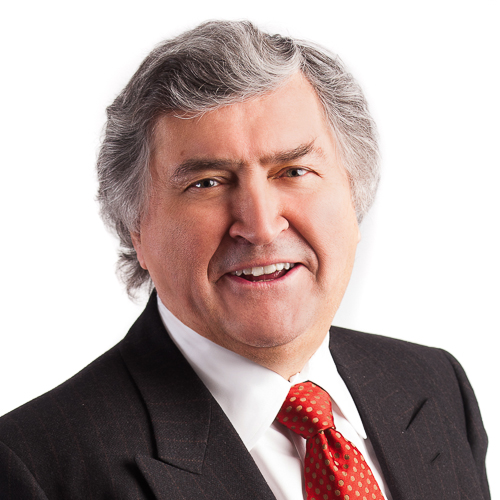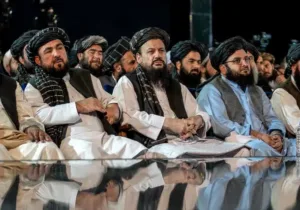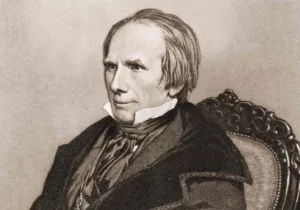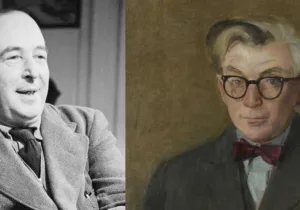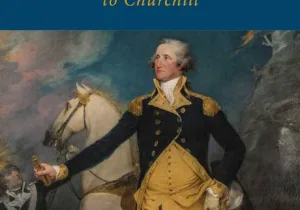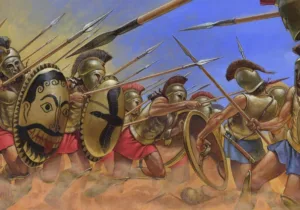At the Christianity and National Security Conference, Paul Marshall gave a lecture on the history of Christian-Muslim relations.
Rough Transcript
Thank you very much indeed Mark. Just an advance notice, the screens are at the side of the room, so if you can’t see a screen, you may be missing something. I know many of you will already have a mental map of the world, but I’m not sure if you have a mental map of the world in 750, 1100, and 1500, which is what some of the maps will be. So if you want to position yourself so you can see one of these screens, please do.
What I want to talk about is Christian-Muslim relations, or the relations of probably more Christendom, a cultural political area influenced by Christianity. And we should probably also use the term Islamdom, that is, an equivalent world affected – you know, not all the things Muslims and Muslim-majority countries do are specifically Islamic. But I want to look at the history of these relations. I’m going to cover 1400 years of world history in the next 15 minutes, so I will generalize and lack nuance. And why is this important? America tends to be, of all the countries and cultures in the world, the one that pays less attention to history. Americans will say “Oh, that’s history,” meaning it doesn’t matter. Whereas everybody else in the world will say “That’s history,” which means that that’s central to what’s going on. So we often don’t do that. But you will find in dealing particularly with radical Islam, and that’s mainly what I’ll be focusing on, tons of historical reference. One example: In Afghanistan we’ve been talking about ISK (the Islamic State K or ISIS-K). What’s the “K” stand? It’s Khorasan. What’s Khorasan? We’ll get to that. Years ago Saddam Hussein called George W Bush “Hologu.” What’s he talking about? Well actually, the Mongol leader who leveled Baghdad. So you find all these historical references, which are very meaningful not only to radicals but their audiences, and we often don’t know what they mean. And we should. I don’t know if you’ve ever looked at Ambrose Bierce’s book The Devil’s Dictionary. I strongly advise it; it has a very high level of sarcasm. The entry under war says this, “War: War is God’s way of teaching Americans geography.” And I think it should also be God’s way of teaching Americans history.
So we will begin with this: Muhammad, Islam’s prophet, was successful. He was successful as a religious leader. He started what is the world’s second largest religion. He was successful as a political leader. If you see the map, the dark purple area, that was the area controlled by Muhammad and his followers at the time of his death. So he was also successful as a military leader, and that success continued. If you look at the middle purple area, this was the extent of Muslim rule approximately 60 years after Muhammad’s death. If you look at the entire purple area, with the light purple you see over there in Spain and east in China, that’s the situation in 750. So you’re seeing control from the Atlantic to the eastern boundary of that in India and China, so from China to the Atlantic in one century. This rapid conquest indeed, it misses some things. There it’s just showing control of Spain, which lasted for 800 years, but in 732, 100 years after Muhammad’s death, there were Muslim armies 120 miles south of Paris. So you have this major expansion. Now we don’t like empires generally, but my comment isn’t so much that this was a terrible thing. The point is if the Persians could have done this, they would have done. If the Byzantines could have done it, they would. That’s what empires do. The main thing I want to focus on is just the success – an empire from China to the Atlantic Ocean in 100 years. So there’s this major spread. Next slide – this is the situation in 1100. And those of you will good eyesight will notice a green line which goes down the coast of Spain, down West Africa, across Africa, down the east coast as far as Mozambique, then up again into India and then moving into Central Asia. This is the area controlled by Muslim rulers in the year 1100. Next slide, we’re leaping ahead here to 1500. You see that same line, now it’s moved into West Africa, it’s coming down into Nigeria again, down the east coast of Africa including Mozambique, then taking in 90 percent of what is India, then moving across to Malaysia, parts of Thailand, Indonesia, and the southern Philippines, right through Central Asia, and then expansion into Europe. You should know that over half of Europe has at some point been under Muslim rule for a period of over two centuries. That is often a thing which is forgotten. If you want to know why people in Hungary get worried about immigration, largely Muslim immigration, it’s because they were ruled by the Ottomans for centuries. So here you have this very rapid picture of expansion, some setbacks, but here you have Islamic civilization stretching from the Philippines to west Africa, from what is Mozambique up to the rivers emptying into the Arctic. That continued further expansion into the Balkans, laying siege to Vienna on two occasions. So you have this expansion. So with Islam, this is oversimplified, but there is an expectation of success. The theme of long-suffering is much less a theme in Islam than it would be in Christianity. But here secular history and sacred history are one. You expect success; you’ve got it. You have a thousand years of stunning success. Not only do you have control – this is not one country, of course, there’s all sorts of fiefdoms and there’s wars going on inside it – but it’s definitely Muslim and Islamic. It’s also militarily the most powerful, politically the most powerful, it’s the richest, most of the trade is there, and culturally, at least in its earliest centuries, culturally and intellectually it was very powerful. It really had no challenges. China remained within its own border. The Christian-controlled part of Europe, the cold and wet northwest, wasn’t really much of a challenge. So here you have the situation roughly a thousand years after Muhammad’s death.
Then things changed. They changed slowly. History doesn’t immediately turn round. They started to lose more battles, then they started to lose more battles than they won, and then in headlong retreat. So what happens, firstly, Muslims are driven out of Spain. Finally in 1492, the last Muslim-controlled area in Granada was defeated. This was, by the way, why the Spanish ruler Philip was feeling so good the day that Columbus came to him applying for a grant to mount an expedition across the Atlantic. Same city, same time. So push-back in Europe, gradually pushing back in the Balkans; the Russians start pushing the Tatars south into what is now Ukraine, start taking over Central Asia, so the push-back over the remaining Christian-majority lands, and then the phenomenon we call colonialism. I think it’s a bad term. I think we should just use the old term imperialism, because colonialism implies this is a new phenomenon in the world. It’s not. It’s the same old phenomenon. What is different is it’s largely maritime. Most empires conquer the people next-door on the land mass and go overseas, like the Aegean, but basically it’s that what was unusual about the Europeans is they were sailing to these places. So that the Portuguese, largely to get around the fact that having to trade with the east, you had to trade through 5,000 miles of Muslim lands – which was fine; people were trading, they weren’t making war against each other all the time – but it cost a lot. So Columbus wanted to try and sail around the Islamic world to reach the east. The Portuguese did the same sailing around southern Africa, and they began to take over portions of Africa and establish the base in what is now Yemen. The Portuguese began an aborted expedition to conquer Mecca in 1506, and then the Portuguese go on, establish bases in India, then on to Indonesia. The Dutch start doing the same, the British start doing the same. So in the end large chunks of Africa, of India, the Indian subcontinent, Malaysia, Indonesia were controlled by European powers. For Muslims and for many Christians, that is Christian powers. When India was taken over, the majority of the rulers were not Hindu but Muslim. So you’re having a displacement throughout the world of Muslim rulers by Christian rulers, and this was often interpreted in religious terms. So you’re getting this reversal; you can’t put a specific date, as I mentioned, history does not turn on a dime, but if I wanted to put one symbolic date for this, I would pick September the 11th, 1683. This was the failure of the second Ottoman siege of Vienna. And again, I don’t know your background teaching, but so many people I find simply do not know that when Martin Luther was writing about the Turks, they weren’t that far away from where he was writing, you know, 150 miles. He wasn’t talking about people in Turkey. But this was the failure of the second siege of Vienna. The Ottomans had been on the gates of Vienna before but withdrew. But this time they suffered a bad defeat and fled, left their camp behind, which one story has it is how the Europeans discovered coffee, because it was left behind them. But the Turks then were driven out of Austria, driven out of Hungary, driven out of what is now Serbia, Bosnia Romania. Greece fought for independence. This movement goes on. So one phase is sort of the European powers pushing back. A second phase is colonialism, or maritime expansion, of a takeover by normally Christian powers over normally Muslim powers throughout the world.
And then things get worse yet. Now if we move on to the beginning of the 20th century, after the First World war – if you remember, the Ottoman Empire, at least its remains, allied with Germany and Austro-Hungary, that is they allied with the losing side – and so as usual in these conflicts, it was carved up. France and Italy had already taken over portions of North Africa, and after the First World War, France was given control over what is now Lebanon and Syria. The British were given control over what is now Israel, the Palestinian areas, Jordan, Iraq, parts of Saudi Arabia, and Egypt was nominally independent but the British remained a power. They managed to hang on for 150 years after they defeated Napoleon there by promising to leave in 10 years time, and they did that every 10 years. So this left only four or five areas of the globe, Muslim-majority areas, which actually had Muslim rulers. These were Turkey, Afghanistan, Iran, then sort of Saudi Arabia and Yemen. But Turkey was highly secular. Ataturk, the ruler of Turkey, wanted to get rid of Islamic elements. He changed the alphabet away from Arabic. He banned the wearing of the fez, the hat without the brim. If you have a brim it’s much harder if you’re a Muslim to pray because you’ve got the front of the thing – your head is supposed to touch the ground and the fez was handy because you could keep your hat on and do it. Anyway that was banned. And on March the 3rd, 1924, Ataturk abolished the caliphate, the nominal ruler of all the Muslims. An institution which had existed for 1300 years, he gets rid of. So Turkey doesn’t really count; it’s highly secular. Iran has some similarities, Afghanistan is sort of way out there. So this left the Arabian peninsula, particularly after the Saudis took over in the 1920s and called it, with due modesty, “Saudi” Arabia. This was the only significant part of the Muslim world actually being run by Muslims in the 1920s. So if you are looking at a calendar from the point of view of many Muslims, the 1920s is highly significant. If you go through Osama bin Laden’s various speeches, he always refers to it. In his major video after the attacks on the U.S. in 2001, the September 11 attacks, he says following World War One, which ended more than 83 years ago, the whole Islamic world fell under the crusader banner, under the British, French, and Italian governments; they divided the whole world. By and large he’s correct, but this is often the sort of history that we are not used to. So what you have is, again in oversimplified terms, in the Islamic world a thousand years of stunning success followed by 300 years of crushing failure. And it appeared in the 1920s when, to be generous, maybe 10 percent of Muslims actually lived under Muslim rulers. So if you want to know why there’s a lot of anger in the Islamic world, this is the reason. There is a response, “Well you invaded us first.” You know, we could go back to the map in 1500, but as any of you who are married or many of you who are not married know, “You did it first” is an argument which really doesn’t get you very far. So you have this situation of being put upon, then it actually gets even worse, because we mentioned Saudi Arabia as the only sort of largely self-governing Muslim-majority area, and there weren’t infidel powers in there, and then Saddam Hussein invades Kuwait. And in 1990 what happens is in the only area normally independent, without foreign troops or powers, some soldiers arrive, say “We’re from America and we’re here to help.” This was the lead into the First Gulf War, and asked by the Saudi government, otherwise Saddam would have just kept going south and taken the oil fields. But from many Islamic perspectives, and particularly for the radical views, what do you see? You see the world gradually imploding and squeezing in. Probably have to be from Europe can control throughout the world through colonialism, the takeover of the heartland, the Middle East itself, and then suddenly you get American and other troops in Saudi Arabia. Let me quote bin Laden again, “This is the latest and greatest aggression. Now infidels walk on the land where Muhammad was born and where the Quran was revealed.” The latest and greatest aggression – that was always his particular idea.
So this brings the question of why. A thousand years of stunning success followed by a 300 years of crushing failure, why did this happen? Many of you will know Lewis’s book What Went Wrong. My lecture here has basically been “What Went Wrong for Dummies” or the shortened version. And broadly two responses, this is we failed because we didn’t keep up. We rejected foreign ideas, we became closed off, we became rigid, we thought we had all the resources within ourselves, and we should have learned more, we should have learned what is it that’s given the West this success, how can we do it? The other view is almost entirely opposite, saying when we were good Muslims we succeeded. It was when we ceased to be good Muslims that we no longer followed Islamic law, sharia, that we were no longer obedient, when we were no longer willing to die that things fell off. So the solution is to get back to the purity of original Islam, and this you will see very much in ISIS. And al-Baghdadi proclaims the caliphate again, with of course himself as the caliph.
Radical organizations, largely non-violent in most parts of the world but maybe not all, Hizb ut-Tahrir made the major caliphate organization. This is its map of the caliphate it wants. The area in blue is what they want to control. And if you remember the map with the red areas once controlled by Muslims, this is pretty well the same map. They miss a few bits, but they even leave southern India out of it because it was under that control. So it’s a restorationist movement wanting to do this. This is Hizb ut-Tahrir.
And this is ISIS’ map of its future Islamic State caliphate. Interesting, it misses out much of India, Bangladesh, Indonesia, three out of four of the world’s largest Muslim population countries. But this is their map, this is the caliphate they want to get back to. And you’ll see the the big black area, top right hand corner, is of course Khorasan, and the ISIS in Afghanistan names itself for that. You can see they want big chunks of Europe back again, between Greece, probably Italy. The churches in Rome were burned by Arab armies in the ninth century. But this is the more radical restorationist movement, and it fights. So that division about which way to go is between radical elements, and not only them, but sort of back to pure Islam as they believe it was in the 7th century. There are others saying we must learn and adapt. So this is an ongoing conflict within the Muslim world, but it also provides the rationale for especially terrorist groups, but radical groups but more generally – a strong sense of grievance in the Muslim world and amongst Muslims about the relationship over the last 1300 years, especially the last 300. So I’m just going to leave this as a sort of historical background. A major thing I want to emphasize is we need to be aware of this type of history because it’s the history which lives in the minds of many Muslims and very strongly in radicals. And we won’t understand what it is they’re trying to do unless we are aware of that, and sadly too often we are not. I was reading a report on the failures of reconstruction in Afghanistan, a U.S. government inspector general’s report, which is remarkable for the fact that the word “Islam” does not occur in its 90 pages except in titles. There’s one paragraph when it talks about Islamic finances, and of course names like Islamic State, but it’s not substantively dealt with as a factor in terms of understanding Afghanistan. So we need to get out of some of our myopia and take this history seriously.
Q: In the world view of people who wish to establish a physical caliphate, where do muslims overseas fit in? I’m from a part of New Jersey that’s known as Little Ramallah because it’s around one-third Palestinian. Do they want people to come back to almost like an Islamic Zionism or do they want to extend the borders even further?
Marshall: Especially for ISIS, it’s to come back. So those invitations – we’ve established the caliphate, we have land, everybody come here. Historically there has not been a rationale for Muslims to live under non-Muslim rule. So if you’re in that situation, if you’re an ambassador you’re okay, if you’re a merchant you can go there and do that, so there would be interaction, but normatively you have to live under Muslim rule. Otherwise you cannot be a good Muslim. So it’s people should come back and then expand. They probably wouldn’t expect, say, like the population of Egypt to move over to Iraq. But people in New Jersey, certainly, and other parts of the diaspora. Normatively, you have to live under a Muslim ruler.
Q: A couple of curiosities about your talk, maybe more certain questions. I’m very fascinated by the history of Islamic rule in India, where I think the common story that Westerners are told is that there were the Indians, the Hindus ruling themselves and the British came in and displaced that with European rule. It’s of course more complicated to find out that the Hindus of India were living under an Islamic rule that they found presumably not too good, and then the British came and displaced them. But thinking about the history of Islamic-Hindu relations, which I find so fascinating, and then secondly thinking about in the 60s and 70s the pan-Arab nationalism, like under Nasser. I don’t believe they used the language of a caliphate but that did seem to be the closest thing in modern history, not that ISIS was ever actually going to achieve anything they wanted to but who could have actually brought a really high degree of Islamic or at least Arab unity, it seems like Nasser became the closest. But I’m wondering if you have any like thoughts on what the future of a pan-Arabism or Islamism could be.
Marshall: Someone once said predictions are hard, especially about the future. I’m not sure pan-Arabism is going to go far. I think it’s dead. Who knows 1500 years from now, but in the next few decades I don’t think it’s much of a factor, with one qualification. And partly pan-Arabism was seen as an alternative to Islamism. Islamism wants to unite Muslims, whereas Arabism wants to unite Arabs. Now Arabs are the people who speak the language of the prophet, the language of the Quran, so in that sense they are, and generalization often see themselves as the better Muslims. And often you get resentment from other Muslims. But Arab is not the same as Muslim, and there’s tons of non-Arabs as well as non-Muslims in the Middle East. So it was mainly an alternative, a sort of quasi-nationalism, can we get an Arab state which would be able to compete say with Turkey or Iran? Now you’re getting sort of more Arab unity at least in the Middle East because of Iran. And again, this is another historical pattern. Iran is doing what it’s been doing for almost 3,000 years, which is coming down from the mountains and trying to take over the heartland of the Middle East, the land of the two rivers. So in that sense another historical pattern is coming back. So there’s uniting against Iran, but giving concrete political form to an Arab identity, I don’t think that’s on the cards, at least for a while.
Q: So in understanding these historical perspectives and motivations behind these groups in the face of Western subjugation or colonization of these areas, how can this knowledge of history be applied practically to our policy approaches? What’s the most important thing for us to focus on?
Marshall: The major thing is, what are their goals? What are they seeking to achieve? Mary Habeck, a book she has written you know dealing with the worldview and how it affects the military doctrine of radical Islamic groups, puts this in terms that are militarily useful, that is, what are they trying to achieve. And if you just take it now with the Taliban, the Taliban largely fit in this. The discussions about how we’re going to relate to the Taliban; it says, well they want to be accepted by the world community. No they do not! They don’t care about the world community, they don’t believe any such thing as the world community is the ummah, the Muslim world and the infidels. But this pattern of ignoring what people say to you very clearly that they want and what they’re striving for. So in terms of our diplomatic engagement, that needs to be part of that. Of course they’ll make deals with Russia and make deals with China, they can make deals with us, all sorts of tactical things, but in terms of understanding what they want and what they’re likely to do militarily and their relationship with al-Qaeda, these things are key. And as Eric Patterson said earlier, the senior guy at the pentagon says al-Qaeda is probably going to be in a position to attack the American mainland within 12 months. And why does it want to attack the American mainland? Well it goes back to this: we’re the far enemy. We’re the ones stopping them taking over the Muslim world.
Q: I had a question about this idea of a third caliphate, and we kind of talked about individual groups. How hard would it be for the different groups in the Middle East to actually band together as one unit to try and take over?
Marshall: We’re dealing not just with the Middle East. We’re dealing with the southern Philippines, we have been dealing with southern Thailand, certainly Indonesia, and many other places. But here you need to look at Somalia, al-Shabaab. ISIS is active, killed thousands of people in Mozambique, we’re talking about right next to South Africa. We’ll talk about southern Africa, and the most deadly place is of course west Africa. Far more people there are being killed by Islamist terrorist groups than are in Afghanistan or the Middle East. Probably over the decades several hundreds of thousands dead and thousands a year, 10 to 15 thousand. So you’re dealing with this phenomenon throughout the world. You’re dealing with it now in Congo, northeastern Uganda Kenya, throughout west Africa. When the Europeans and Americans destroyed Libya, many of the terrorists and their weapons move south into the Sahara and are very active. So you’re dealing with a worldwide phenomenon here. Again if I’m not imputing this to you, let’s not think Muslim Middle East. Most Muslims live east of Pakistan, by population largely an Asian religion. The Middle East is the heartland, so it has much more influence. But in terms of what is going on and where people are being killed, they’re all over the place. Now to your question, which I didn’t repeat, but to what degree is it possible these groups can unite and re-establish and work to re-establish the caliphate, many of these groups are in fact seeking various alliances. In west Africa, some groups are swearing fealty to al-Qaeda, others to ISIS. So they’re attempting to unite, but in different groups, and they fight each other. I know one of the senior special forces guys who said well, at one level, you don’t have to worry about these guys less because they’re all going to kill each other, which they do. ISIS and al-Qaeda are fighting in west Africa. So I think you can unite and engage in guerrilla warfare throughout the world and terrorism, which they’re doing. To do so at a larger scale, I don’t think so. There’s just so much conflict. You have ISIS now fighting the Taliban and al-Qaeda in Afghanistan. So the possibility of them achieving this is very low.
